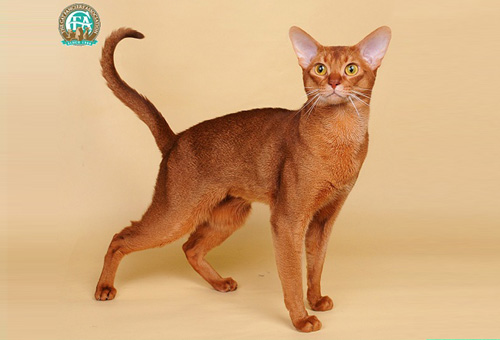

Although the Abyssinian is one of the oldest known breeds, there continues to be speculation and controversy concerning its history. In appearance, Abyssinians resemble the paintings and sculptures of ancient Egyptian cats which portray an elegant feline with a muscular body, beautiful arched neck, large ears and almond shaped eyes. Abys today still retain the jungle look of felis lybica, the African wildcat ancestor of all domestic cats.
 The source of the name is not because Ethiopia, formerly Abyssinia, is thought to be the original home of these cats, but because the first “Abyssinians” exhibited in shows in England were reported to have been imported from that country. The first mention is in the Harper’s Weekly (January 27, 1872 issue) where the 3rd prize in the December 1871 Crystal Palace show was taken by the Abyssinian Cat “captured in the late Abyssinian War.” This article is accompanied by an illustration of the Abyssinian Cat. In the British book, by Gordon Stables, Cats, Their Points, and Characteristics… published in 1874, there is also mention of an Abyssinian. The book shows a colored lithograph of a cat with a ticked coat and absence of tabby markings on the face, paws, and neck. The description reads: “Zula, the property of Mrs. Captain Barrett-Lennard. This cat was brought from Abyssinia at the conclusion of the war…” British troops left Abyssinia in May 1868, so that may have been the time when cats with ticked coats first entered England. Unfortunately, there are no written records tracing the early Abyssinians to those imported cats, and many British breeders are of the opinion that the breed was actually created through the crossing of the various existing silver and brown tabbies with native British “Bunny” ticked cats.
The source of the name is not because Ethiopia, formerly Abyssinia, is thought to be the original home of these cats, but because the first “Abyssinians” exhibited in shows in England were reported to have been imported from that country. The first mention is in the Harper’s Weekly (January 27, 1872 issue) where the 3rd prize in the December 1871 Crystal Palace show was taken by the Abyssinian Cat “captured in the late Abyssinian War.” This article is accompanied by an illustration of the Abyssinian Cat. In the British book, by Gordon Stables, Cats, Their Points, and Characteristics… published in 1874, there is also mention of an Abyssinian. The book shows a colored lithograph of a cat with a ticked coat and absence of tabby markings on the face, paws, and neck. The description reads: “Zula, the property of Mrs. Captain Barrett-Lennard. This cat was brought from Abyssinia at the conclusion of the war…” British troops left Abyssinia in May 1868, so that may have been the time when cats with ticked coats first entered England. Unfortunately, there are no written records tracing the early Abyssinians to those imported cats, and many British breeders are of the opinion that the breed was actually created through the crossing of the various existing silver and brown tabbies with native British “Bunny” ticked cats.
Recent studies by geneticists show that the most convincing origin of the Abyssinian breed is the coast of the Indian Ocean and parts of Southeast Asia. In fact, the earliest identifiable Aby is a taxidermal exhibit still residing in the Leiden Zoological Museum in Holland. This ruddy ticked cat was purchased around 1834-1836 from a supplier of small wild cat exhibits and labeled by the museum founder as “Patrie, domestica India.” Although the Abyssinian as a breed was refined in England, its introduction to that country and others may have been the result of colonists and merchants stopping in Calcutta, the major port for the Indian Ocean.
 The first Abyssinians to be imported to North America from England arrived in the early 1900s, but it was not until the late 1930s that several top quality Abys were exported from Britain to form the foundation of today’s American breeding programs.
The first Abyssinians to be imported to North America from England arrived in the early 1900s, but it was not until the late 1930s that several top quality Abys were exported from Britain to form the foundation of today’s American breeding programs.
As described in the Abyssinian Breeders International Kitten Buyer’s Guide by Carolyn Osier, “Abyssinians must be one of the most intelligent animals ever created.” This handbook for the potential Aby owner describes these cats as “a very people-oriented cat. Not a lap cat…but a cat that likes to be with people, a cat that wants to know what you are doing – that wants to help. There is probably no breed anywhere more loyal than the Aby. Once you have acquired an Aby as a companion, you will never be able to complain that no one understands you. Abys are very good at training people to do just what they want them to do.”
Pricing on Abyssinians usually depends on type, applicable markings, and bloodlines distinguished by Grand Champion (GC), National or Regional winning parentage (NW or RW), or Distinguished Merit parentage (DM). The DM title is achieved by the dam (mother) having produced five CFA Grand Champion/Premier (alter) or DM offspring, or the sire (father) having produced fifteen CFA Grand Champion/Premier or DM offspring. Usually breeders make kittens available between twelve and sixteen weeks of age. After twelve weeks, kittens have had their basic inoculations and developed the physical and social stability needed for a new environment, showing, or being transported by air. Keeping such a rare treasure indoors, neutering or spaying, and providing acceptable surfaces (e.g. scratching posts) for the natural behavior of scratching (CFA disapproves of declawing or tendonectomy surgery) are essential elements for maintaining a healthy, long, and joyful life. For more information, please contact the Breed Council Secretary for this breed.